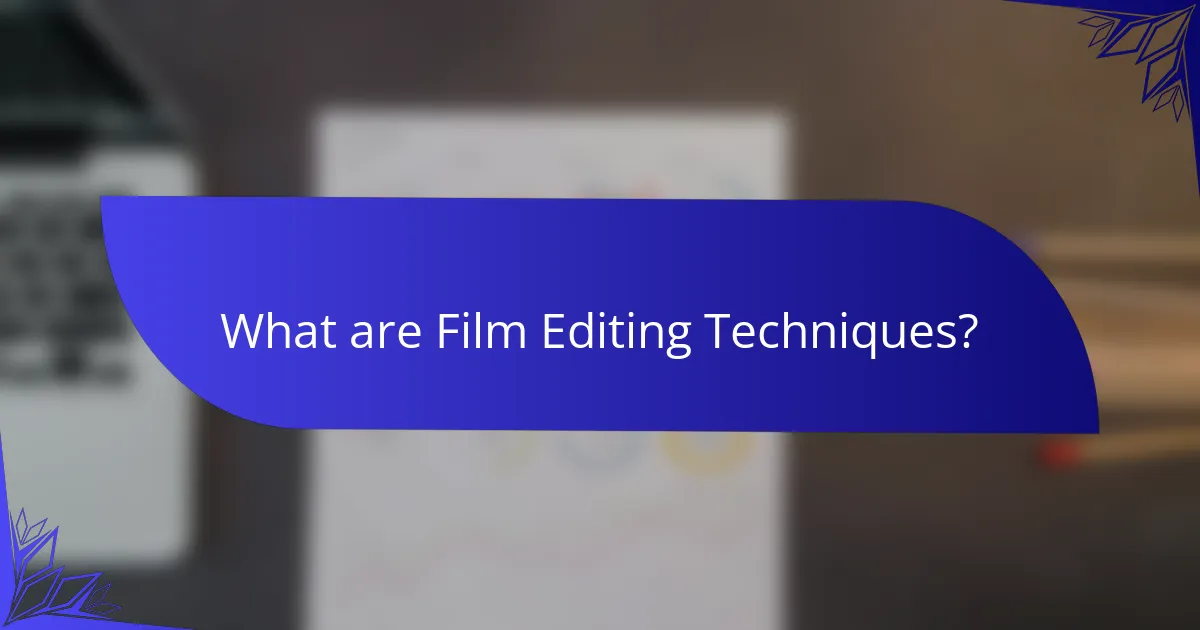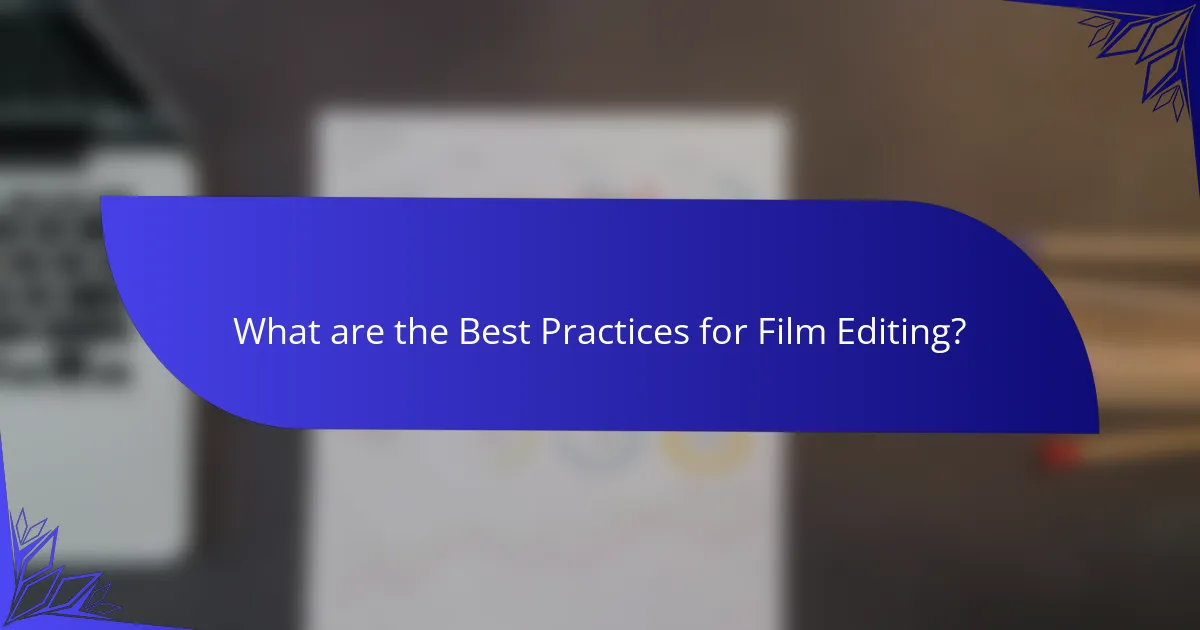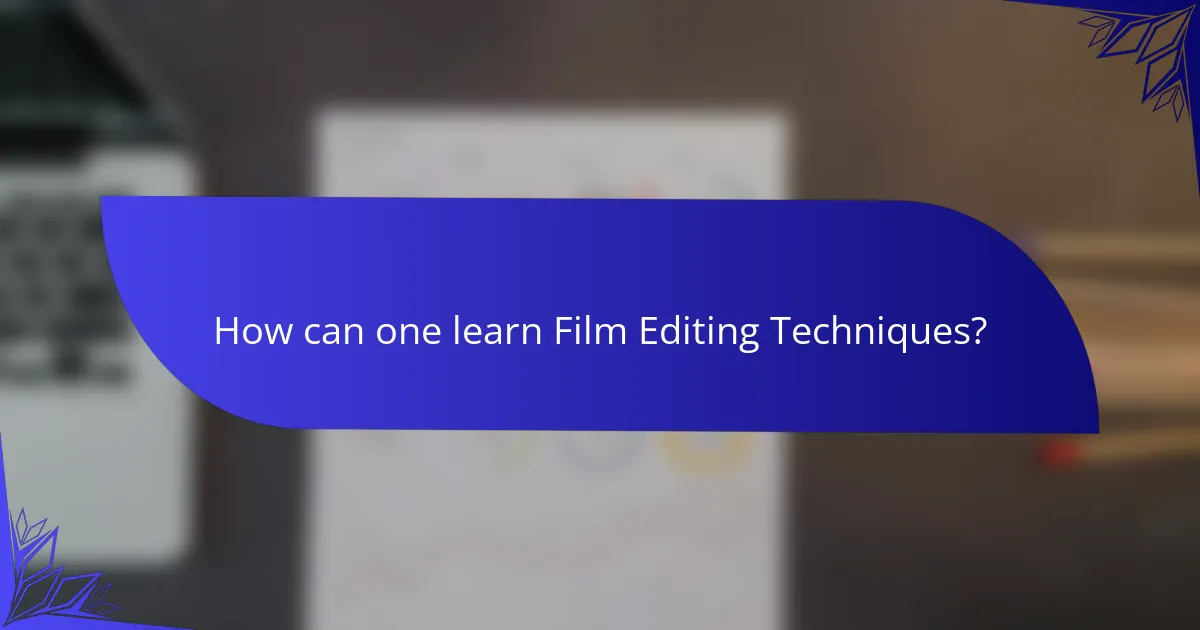Film editing techniques are essential methods for assembling and manipulating footage in filmmaking, including cutting, transitions, and pacing. Key practices involve maintaining narrative structure and continuity while effectively managing pacing to enhance viewer engagement. Historical examples, such as Sergei Eisenstein’s montage, underscore the significance of these techniques in shaping storytelling. Aspiring editors can learn these skills through formal education, practical experience, and critical analysis of films, as well as by participating in editing communities and utilizing various resources. This article provides a comprehensive overview of film editing techniques, best practices, and learning pathways for those interested in the craft.

What are Film Editing Techniques?
Film editing techniques are methods used to assemble and manipulate footage in filmmaking. These techniques include cutting, transitions, and pacing. Cutting involves selecting and splicing together shots to create a coherent narrative. Transitions, such as fades and wipes, help shift from one scene to another smoothly. Pacing refers to the rhythm and timing of the edits, influencing the film’s emotional impact. Techniques like montage and cross-cutting create dynamic storytelling by juxtaposing different scenes. The use of these techniques is essential for shaping the viewer’s experience. Historical examples, such as Sergei Eisenstein’s use of montage, illustrate their significance in film history.
How do Film Editing Techniques impact storytelling?
Film editing techniques significantly impact storytelling by shaping narrative structure and emotional engagement. Editing determines the pacing of a film, influencing how viewers perceive time and tension. Techniques like cross-cutting build suspense by juxtaposing different scenes. Montage sequences can condense time and convey complex ideas quickly. The use of jump cuts can create a sense of urgency or disorientation. Transitions between scenes guide audience expectations and emotional responses. Research by Bordwell and Thompson in “Film Art: An Introduction” highlights how editing can manipulate viewer perception. Effective editing enhances storytelling by ensuring clarity and coherence in the narrative.
What role does pacing play in film editing?
Pacing in film editing determines the rhythm and flow of a film. It influences the emotional impact and engagement of the audience. Proper pacing can build tension, enhance storytelling, and maintain viewer interest. Editors manipulate pacing through the length of shots and the speed of cuts. For instance, quick cuts can create a sense of urgency. Conversely, longer shots may evoke contemplation or emotion. Studies indicate that pacing affects audience perception and retention of narrative. Effective pacing is essential for achieving the desired mood and tone in a film.
How does editing shape audience perception?
Editing shapes audience perception by controlling the narrative flow and emotional impact of a film. It determines how viewers experience time and space within the story. For example, quick cuts can create a sense of urgency, while long takes can evoke contemplation. The arrangement of scenes influences the audience’s understanding of character motivations and plot developments. Editing also establishes pacing, which affects how tension and resolution are perceived. Studies show that editing techniques significantly impact audience engagement and emotional responses. Research by Bordwell and Thompson highlights the importance of editing in shaping viewer interpretation. Effective editing can enhance storytelling, leading to a more immersive experience for the audience.
What are the key methods in Film Editing?
The key methods in film editing include linear editing, non-linear editing, and montage. Linear editing involves assembling footage in a sequential manner. This method was prevalent before digital technology. Non-linear editing allows editors to access any clip in any order. It provides flexibility and efficiency in the editing process. Montage is a technique that juxtaposes different shots to create meaning. This method can evoke emotions or convey complex ideas quickly. Each method serves distinct purposes and enhances storytelling in film.
What is continuity editing and why is it important?
Continuity editing is a film editing technique that ensures a seamless flow of action and maintains spatial and temporal consistency. It is important because it helps the audience follow the narrative without confusion. This technique involves matching actions, eyelines, and the position of objects between shots. By maintaining continuity, filmmakers create a coherent story that feels realistic. Effective continuity editing enhances viewer engagement and emotional investment in the film. It is widely used in mainstream cinema to uphold storytelling clarity. Studies show that poor continuity can distract viewers and disrupt narrative immersion.
How does montage editing differ from traditional editing?
Montage editing differs from traditional editing in its approach to storytelling. Montage editing emphasizes the juxtaposition of images to create meaning. It often condenses time and space to convey a broader narrative or emotional impact. In contrast, traditional editing focuses on continuity and the seamless flow of scenes. Traditional editing aims to maintain a coherent narrative structure. The use of montage can evoke specific emotions or themes through rapid image sequences. Historical examples include Sergei Eisenstein’s films, which utilized montage to enhance dramatic effect. Traditional editing, exemplified in Hollywood cinema, prioritizes clarity and audience comprehension.
What tools are commonly used in Film Editing?
Common tools used in film editing include software like Adobe Premiere Pro, Final Cut Pro, and Avid Media Composer. These programs provide essential features for video cutting, transitions, and effects. Adobe Premiere Pro is widely used for its versatility and integration with other Adobe products. Final Cut Pro is favored for its user-friendly interface and efficiency on Mac systems. Avid Media Composer is known for its robust collaboration tools, making it popular in professional environments. Additionally, hardware tools such as control surfaces and external storage devices enhance the editing process. Control surfaces allow for tactile control over editing software, improving workflow. External storage devices ensure that large video files are managed effectively.
What software is essential for film editors?
Adobe Premiere Pro is essential for film editors. It offers comprehensive editing tools and supports various formats. Final Cut Pro is another key software, particularly favored by Mac users. Avid Media Composer is widely used in professional film production. DaVinci Resolve is known for its advanced color grading capabilities. These software options are industry standards, ensuring editors can meet diverse project requirements.
How do hardware choices affect the editing process?
Hardware choices significantly impact the editing process by influencing efficiency and quality. Powerful processors enable faster rendering of video files. High RAM capacity allows for smoother multitasking during editing. Graphics cards enhance playback quality and effects processing. Storage speed affects file transfer rates and access times. Larger monitors provide better visual clarity and workspace for editing. Ergonomic peripherals improve user comfort and productivity. Each of these hardware components directly contributes to the overall effectiveness of the editing workflow.

What are the Best Practices for Film Editing?
Best practices for film editing include maintaining a clear narrative structure, ensuring continuity, and using pacing effectively. Editors should prioritize storytelling by selecting the best takes that enhance character development and plot progression. Continuity is crucial; editors must keep track of visual and audio elements to avoid jarring transitions. Effective pacing helps maintain audience engagement; editors can vary shot lengths to create tension or relief. Additionally, utilizing transitions and effects judiciously can enhance the overall flow without distracting from the story. Regular collaboration with directors and sound designers ensures a cohesive final product.
How can editors enhance their workflow?
Editors can enhance their workflow by utilizing efficient software tools. These tools streamline editing processes and improve productivity. Popular editing software includes Adobe Premiere Pro and Final Cut Pro. They offer features like multi-camera editing and automated color correction. Editors can also adopt project management systems to organize tasks. Systems like Trello or Asana help in tracking progress and deadlines. Collaboration tools enhance communication among team members. Real-time feedback can lead to quicker revisions and better outcomes. Additionally, continuous training on new techniques keeps editors updated with industry trends.
What techniques improve collaboration with directors?
Effective communication enhances collaboration with directors. Clear dialogue ensures mutual understanding of creative visions. Regular check-ins foster alignment on project goals. Utilizing shared digital tools streamlines feedback and revisions. Establishing a collaborative workflow encourages input from both parties. Active listening demonstrates respect for the director’s vision. Providing visual references aids in conveying ideas effectively. Acknowledging and adapting to the director’s style promotes a harmonious working relationship.
How can feedback be effectively integrated into the editing process?
Feedback can be effectively integrated into the editing process through structured communication and iterative revisions. Editors should establish clear channels for receiving feedback from directors, producers, and test audiences. This ensures that all perspectives are considered. Regular feedback sessions can be scheduled to discuss specific scenes or sequences. Editors can document feedback to track changes and ensure that all suggestions are addressed. Implementing feedback should be prioritized based on the project’s vision and goals. This approach enhances collaboration and improves the final product. Research shows that iterative feedback leads to higher quality outcomes in creative projects.
What common pitfalls should editors avoid?
Editors should avoid several common pitfalls. One major pitfall is losing sight of the story. This can lead to disjointed narratives that confuse the audience. Another mistake is over-editing, which can strip away essential elements. This often results in a lack of emotional resonance. Additionally, editors should not ignore pacing. Poor pacing can disrupt the flow of the film. Failing to communicate with directors and other team members is another critical error. This can create misalignment in vision and execution. Lastly, neglecting to review footage thoroughly can lead to missed opportunities for improvement. Each of these pitfalls can significantly impact the final product.
How can over-editing impact the final product?
Over-editing can diminish the quality of the final product. It can lead to a disjointed narrative flow. The pacing may become inconsistent, causing viewer confusion. Excessive cuts can disrupt emotional engagement with the content. Overly polished visuals may create an artificial feel, distancing the audience. Additionally, important moments may be lost due to excessive trimming. A study by the American Film Institute highlights that balance in editing is crucial for storytelling. Effective editing should enhance, not overwhelm, the original material.
What mistakes do novice editors frequently make?
Novice editors frequently make several common mistakes. One mistake is neglecting to review footage thoroughly before editing. This can lead to missing important shots or details. Another mistake is failing to organize footage effectively. Disorganization can result in wasted time and confusion during the editing process. Additionally, novice editors often overlook the importance of sound editing. Poor audio quality can detract from the overall viewing experience. They may also rely too heavily on transitions and effects. Overuse of these elements can make the edit feel unprofessional. Lastly, novice editors may not seek feedback from others. Constructive criticism is vital for improvement and growth in editing skills.

How can one learn Film Editing Techniques?
One can learn film editing techniques through various methods. These include enrolling in formal education programs such as film schools or online courses. Many platforms offer specialized courses in film editing, teaching software like Adobe Premiere Pro and Final Cut Pro. Practical experience is essential; aspiring editors should practice by editing their own projects or volunteering on film sets. Additionally, studying films critically helps understand pacing and narrative structure. Joining editing communities or forums can provide valuable feedback and networking opportunities. Resources like books and tutorials also offer insights into advanced techniques and industry standards.
What resources are available for aspiring film editors?
Aspiring film editors have access to various resources. Online courses from platforms like MasterClass and Coursera offer structured learning. Books such as “In the Blink of an Eye” by Walter Murch provide insights into editing philosophy. Software tutorials for programs like Adobe Premiere Pro and Final Cut Pro are widely available. Networking opportunities can be found through film festivals and editing workshops. Online forums and communities, such as Reddit’s r/filmmakers, allow for peer support and advice. Additionally, internships with production companies can provide hands-on experience. These resources collectively support skill development and industry connections for aspiring film editors.
Which online courses provide comprehensive training?
Online courses that provide comprehensive training in film editing include MasterClass, Coursera, and LinkedIn Learning. MasterClass offers courses taught by industry professionals like Martin Scorsese. Coursera features programs from universities, covering both theory and practical skills. LinkedIn Learning provides a variety of courses focused on software like Adobe Premiere Pro and Final Cut Pro. Each platform includes hands-on projects and assessments to reinforce learning. These courses are designed to cater to different skill levels, from beginners to advanced editors.
How can mentorship benefit a film editor’s development?
Mentorship can significantly enhance a film editor’s development. It provides access to industry insights and practical skills. Experienced mentors can share their techniques and workflows. This guidance helps editors refine their craft. Mentorship also fosters networking opportunities within the industry. Such connections can lead to job placements and collaborations. Additionally, receiving constructive feedback from a mentor accelerates skill improvement. Studies show that mentorship increases confidence and job satisfaction among film professionals.
What are some practical tips for effective Film Editing?
Use a clear structure to organize your edits. This helps maintain narrative flow. Focus on pacing to enhance emotional impact. Trim unnecessary footage to keep the audience engaged. Utilize cuts that match the rhythm of the soundtrack. Experiment with transitions for visual interest. Color grading can enhance mood and tone. Regularly review your work to identify areas for improvement. Collaborate with directors and sound designers for cohesive storytelling.
How can one maintain creativity during the editing process?
One can maintain creativity during the editing process by incorporating breaks and seeking fresh perspectives. Taking regular breaks helps to refresh the mind and prevent burnout. Engaging with different media, such as films or art, can inspire new ideas. Collaborating with others allows for diverse input and innovative solutions. Experimenting with various editing techniques can lead to unexpected creativity. Setting specific goals for each editing session can also provide focus and direction. Studies show that a change of environment can stimulate creativity, making it beneficial to edit in different settings.
What strategies help in managing time effectively while editing?
Prioritizing tasks is essential for managing time effectively while editing. Break down the editing process into smaller, manageable tasks. Set specific deadlines for each task to maintain focus. Use editing software that offers time-saving features, such as batch processing. Create a dedicated workspace to minimize distractions. Regularly review progress to adjust timelines as needed. Implementing these strategies can enhance efficiency and productivity during the editing process.
Film editing techniques are essential methods used in filmmaking to assemble and manipulate footage, influencing narrative structure and emotional engagement. Key methods include linear and non-linear editing, montage, and continuity editing, each serving distinct purposes in storytelling. The article covers the impact of pacing, tools commonly used in editing, best practices for effective workflow, and strategies for collaboration and feedback integration. Additionally, it highlights resources for aspiring editors and practical tips to enhance creativity and time management during the editing process.